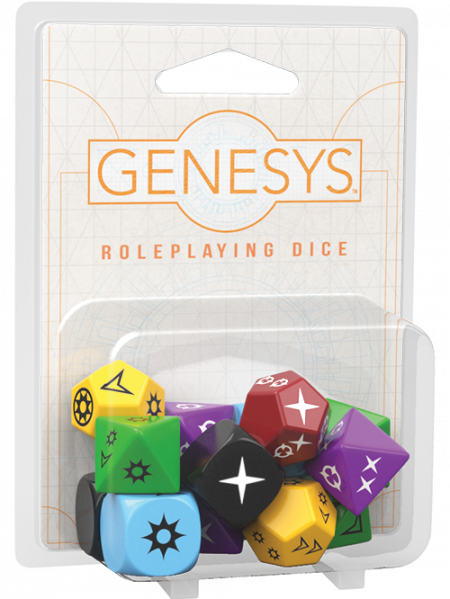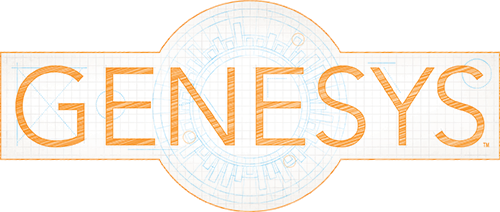Dice Full Of Drama: The Narrative Dice System
The launch of Genesys by Fantasy Flight Games in 2017 marked a significant evolution in narrative mechanics and collaborative storytelling in the TTRPG world. Genesys, building upon the foundations laid by Fantasy Flight's Star Wars RPGs, brought to the forefront a unique storytelling tool with the Narrative Dice System (NDS). This article aims to take a closer look at the narrative prowess of the NDS, showcasing its role in enriching collaborative storytelling, and exploring its possible applications outside of the game room.
Roll and Tell: Genesys Roleplaying Dice

Traditionally, TTRPGs rely on numerical dice rolls (single die roll or dice pool) to determine the successful outcome of a character's action (generally called a 'skill check'). The Game Master (GM) interprets these rolls and describes the outcome of the action at play as part of the unfolding game's narrative. Governed by bell curve probabilities and the contribution of static bonus modifiers (shifting values on the bell curve +1, +2, +3, etc.), this system tends to reduce player agency to tactical decisions, with outcomes largely polarized as 'pass or fail'. Critical successes or failures add extra bonuses or maluses, but the overall player agency over the story remains limited.

Enter the Narrative Dice System! What sets the NDS apart is not just its departure from conventional numerical dice roll outcomes but its impact on collaborative storytelling and the nuanced consequences of each roll. In this system, player and GM work jointly to establish the conflict value of each challenge opportunity, establishing the stakes and influential factors of the action (or scence) at play.
For instance, a player's successful action might simultaneously trigger an unintended complication, enriching the scene with unexpected payoffs - providing new development opportunities for the GM to exploit moving forward.
Dice Description
The NDS uses a set of d6s, d8s, and d12s called Boost (advantage - d6), Ability (skill level - d8), Proficiency (likelihood of success - d12), Setback (disadvantage - d6), Difficulty (difficulty level - d8), and Challenge (likelihood of failure - d12). The NDS doesn't feature numbers but symbols representing Triumph, Despair, Advantage, Threat, Success, and Failure. When rolled, some of these symbols will cancel each other out, while others will be combined, offering a nuanced outcome to interpret.


When a skill check is required, the player assesses their character's skills proficiency (talent and expertise at completing the action), the GM sets the difficulty level and likelihood of failure, and both negotiate additional boosts (bonuses) and setbacks (maluses) by assessing the elements of the scene at play (visibility, terrain, relationship with the characters involved in the scene, relevant aspects of backstory, etc). This discussion frames the conflict of the scene and explores dramatic opportunities around the main challenge. The result of the dice pool will decide if the desired outcome is achieved, its rational degree of success, and creating unexpected outcomes to integrate into the narrative in motion.
A Pivotal System in TTRPG Narrative Evolution
The NDS shifts the focus from linear, numerical outcomes to a more fluid, story-driven approach. Players gain increased control over the narrative, not just in terms of outcomes but in shaping the ongoing storyline of the game session. This empowers players to contribute more significantly to the overall narrative, nurturing a deeper connection to the story and their character.
From a GM's perspective, the NDS invites a more collaborative role. The GM becomes a co-creator rather than a sole conflict designer, integrating new elements into the overarching narrative based on the outcome of dice rolls and players' interpretations. This requires a certain level of improvisation and flexibility, potentially leading to more vibrant and unpredictable game sessions.
Furthermore, the NDS's emphasis on narrative outcomes over numerical success aligns well with current trends in TTRPGs, where character-driven and story-focused play is increasingly favored. It resonates with players seeking a more collaborative gaming experience focused on storytelling, where rules do not get in the way of gameplay.

Learn more about Genesys and the Narrative Dice System by visiting the website of Fantasy Flight Games (no affiliation): Fantasy Flight Games - Genesys.
Other Applications of the NDS
Using the range of success and nuanced outcomes of the NDS, this dice pool could prove itself an inspiring tool for creative and collaborative environments. Overall, the NDS could help you and your colleagues think outside your usual patterns and consider factors you might not have prioritized. This approach could be suitable alternative to classive exercise scenarios or simulations generated by concept blending method.
Some of applications could include creative writing and story development, risk management scenarios, conflict resolution exercises, people management and leadership simulations, and any environment related to the mitigation of nuanced and unpredictable outcomes.
Mentioned in this article: enesys, Narrative Dice System, NDS, tabletop role-playing games, TTRPG, Fantasy Flight Games, collaborative storytelling, game mechanics, skill checks, player agency, narrative outcomes, game master, GM, decision-making, storytelling tools, role-playing dice, gaming innovation, improvisation, character-driven play, story-focused gameplay, creative writing, risk management, conflict resolution, leadership simulations, RPG strategies, player empowerment, narrative evolution, gaming trends, interactive storytelling, decision outcomes
